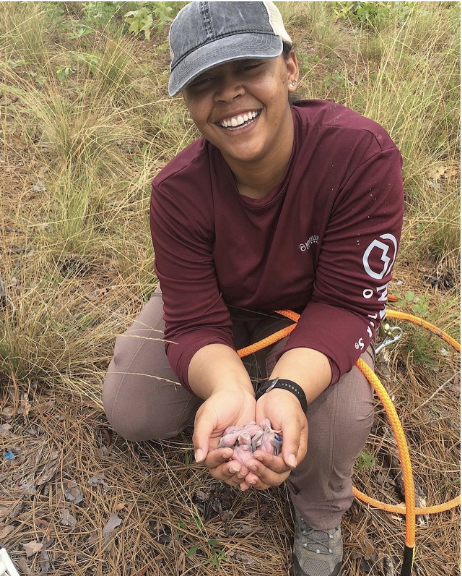
Courtesy of Lauren Pharr
Most of us may have never noticed the flocks of migratory birds flying high above the Wolfpack’s meadows and buildings, but Lauren Pharr, an NC State Ph.D. student and avian ecologist studying the effect of climate change on migratory bird species, takes careful note. Throughout her research, Pharr identified birds as a keystone or indicator species: a species that provides scientists with invaluable information on various environmental conditions.
Pharr has attended NC State for three years, worked with wildlife conservation faculty and was selected as the NC State Forestry and Environmental Resources Faculty Fellow for Excellence in Graduate Education. She recognizes the critical role birds play in our ecosystems, concentrating on the red-cockaded woodpecker endemic to the Southeast as her species of focus.
Through her extensive research, Pharr emphasizes the dire urgency of preventing the damage caused by climate change, including effects of pollution and habitat destruction. Her research as a Ph.D. student will shed new light on how red-cockaded woodpecker populations may be responding to climate change. Pharr emphasizes the importance of preserving the red-cockaded woodpecker’s habitats, which consist of the longleaf pine ecosystem.
Pharr explains how the maintenance of their habitat includes prescribed fires every two to five years, providing the necessary features that red-cockaded woodpeckers favor, such as open midstory tree canopies and the removal of hardwoods.
Currently, this species faces the dire consequences of climate change. Although red-cockaded woodpecker densities have increased over the last few years due to intensive management on federally protected lands, these trends may not persist under a changing climate regime.
“Along with my research, I help the Sandhills Ecological Institute manage 32 of their [red-cockaded woodpecker] groups during the breeding season,” Pharr said. “I am an active member of the North Carolina Prescribed Fire Council, and I occasionally help the Sandhills Prescribed Burn Association with planned burning on both public and private lands.”
The avian ecologist began her journey on the pre-veterinary track but soon decided her interests lay elsewhere. She earned her undergraduate degree in environmental biology at Wingate University, which kindled a turning her passion for birds and wildlife management into a meaningful career.
In her first year as a Ph.D. student at NC State, Pharr was awarded the Southeast Climate Adaptation Science Center Global Change fellowship, which provided funding for her research.
Pharr began her master’s in fall 2019, focusing on citizen science as a channel to present her research. Working alongside her advisor, Dr. Caren Cooper, a professor of forestry and environmental resources, introduced her to the Cardinal Capture project, which involved volunteers netting cardinals in their backyards to examine the effects of urban noise and light pollution on avian physiology and health. However, the project was interrupted due to the COVID-19 pandemic, and Pharr shifted gears to another task. Cooper connected Pharr with some of her colleagues in Washington, D.C. at the Smithsonian Migratory Bird Center.
“I was able to work with their neighborhood NestWatch data, a 40 year data set that they had compiled and that was defined as a citizen science project,” Pharr said. “But instead of avian health, I was looking at the influence of noise and light pollution on avian survivorship.”
The Cardinal Capture project with the Smithsonian Bird Center ended up being Pharr’s choice for her master’s degree, through which she measured avian survivorship in the D.C. area. Throughout her research, Pharr also studied wildlife resources commission and gathered data on the species, working alongside scientists at the Sandhills Ecological Institute in North Carolina.
“Not only am I doing my research, but I’m also helping with the management of the birds as a whole,” Pharr said. “And that has been amazing because I’ve gotten to see and experience what it takes to manage this federally endangered species. I’ve fallen in love with the project and species as a whole.”
Dr. Chris Moorman, professor of avian ecology at NC State and Pharr’s academic co-advisor, speaks highly of Pharr.
“Lauren’s passionate about the work,” Moorman said. “She’s motivated about questions in science, but I think she’s especially driven about sharing what she learns with people, and that’s a really important and maybe undervalued aspect of science. If we just do the work and not share it, it’s like it was never done. She has an incredible track record to demonstrate that already.”
With Moorman’s help, Pharr was able to conduct hands-on work with cardinals for her master’s project. Additionally, Pharr joined forces with the Walnut Creek Wetland Center in Raleigh with two of her Ph.D. colleagues, Murry Burgess and Deja Perkins. The team of ecologists would annually participate in misnetting and bird banding demonstrations with the youth conservation corps and girls in science groups.
Pharr eventually hopes to pursue a career in academia and work to support historically underrepresented students in the natural science field work. The soon-to-be Ph.D. avian ecologist is planning to welcome young scientists into her fascinating area of research and pass on the torch of bird conservation.
“I just love that I can be an inspiration through my work and to others,” Pharr said.